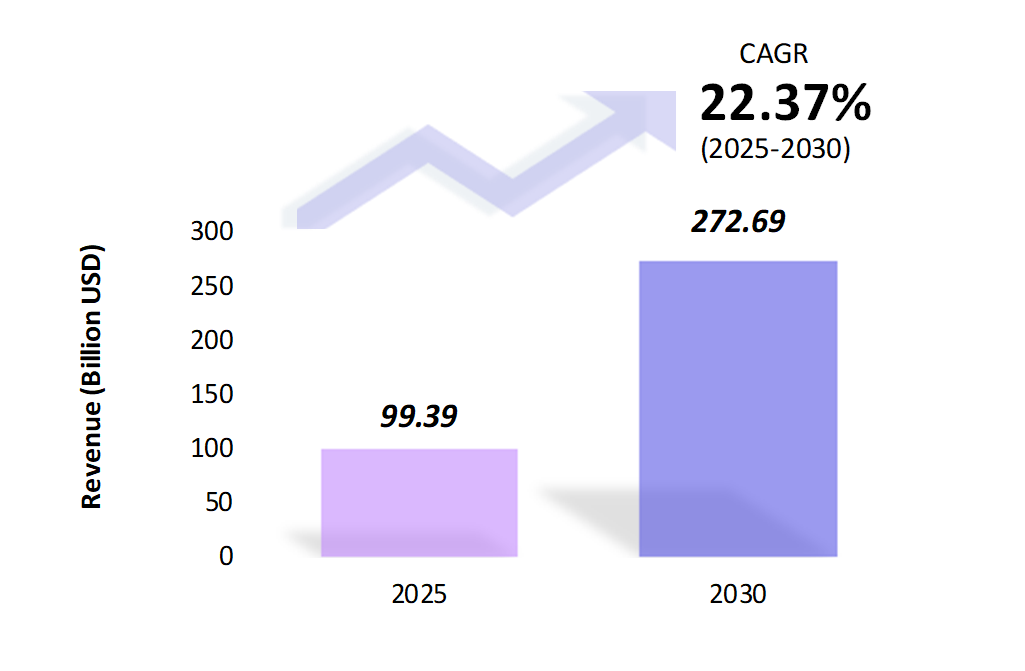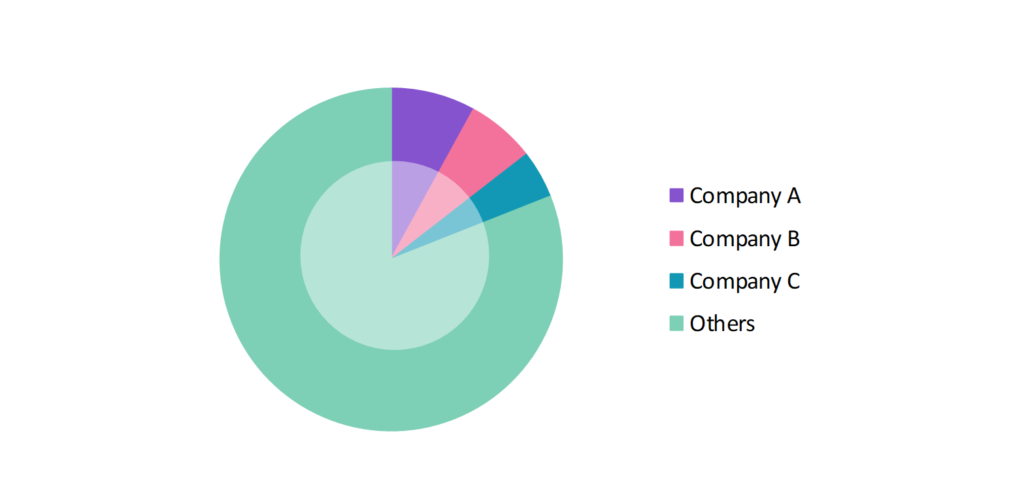Augmented Reality (AR) Market: Size, Share, Trends & Forecast (2024-2029)
The market report provided a comprehensive analysis segmented by Type (Hardware, Software); by End User (Gaming, Education, Healthcare, Retail and Marketing, Automotive, Military and Defense, Others); by Geography (North America, South America, Asia Pacific, Europe, The Middle East, Africa).
Outlook

- The augmented reality (AR) market is estimated to be at USD 99.39 Bn in 2025 and is anticipated to reach USD 272.69 Bn in 2030.
- The augmented reality (AR) market is registering a CAGR of 22.37% during the forecast period 2025-2030.
- The global augmented reality (AR) market is experiencing significant growth, driven by technological advancements, increased adoption across various sectors, and rising consumer demand for immersive experiences.
Request a free sample.
Ecosystem

- Participants in the global augmented reality (AR) industry continually develop strategies to preserve a competitive advantage.
- These companies primarily use acquisitions, research & developments, investments, partnerships, and technological launches.
- Several important entities in the augmented reality (AR) market include Alphabet Inc.; Seiko Epson Corp.; Vuzix Corp.; RealWear, Inc.; Toshiba Corp.; and others.
Ask for customization.
Findings
| Attributes | Values |
|---|---|
| Historical Period | 2019-2023 |
| Base Year | 2024 |
| Forecast Period | 2025-2030 |
| Market Size (2025) | USD 99.39 Bn |
| Market Size (2030) | USD 272.69 Bn |
| Growth Rate | 22.37% CAGR from 2025 to 2030 |
| Key Segments | Type (Hardware, Software); End User (Gaming, Education, Healthcare, Retail and Marketing, Automotive, Military and Defense, Others); Geography (North America, South America, Asia Pacific, Europe, The Middle East, Africa) |
| Key Vendors | Alphabet Inc.; Seiko Epson Corp.; Vuzix Corp.; RealWear, Inc.; Toshiba Corp. |
| Key Countries | The US; Canada; Mexico; Brazil; Argentina; Colombia; China; India; Japan; The UK; Germany; France; UAE; Saudi Arabia; Egypt; South Africa |
| Largest Market | North America |
Get a free quote.
Trends
- Integration of AR in Healthcare: AR is transforming healthcare through applications in surgery, diagnostics, and patient education. Surgeons can use AR for enhanced visualization, while AR-based apps assist in-patient rehabilitation. In 2023, Medivis introduced “AnatomyX,” an AR tool for medical students, which gained widespread adoption for visualizing complex anatomy, demonstrating the growing importance of AR in medical education and training.
- AR-Powered Workforce Training and Support: Companies in manufacturing, logistics, and technical industries are increasingly adopting augmented reality (AR) for remote assistance, hands-on training, and real-time troubleshooting. For example, Boeing uses AR glasses to guide assembly workers, minimizing errors and boosting productivity by providing real-time visual instructions. This technology is transforming operations by improving efficiency and reducing costs.
- Advancements in AR Wearables: The development of lightweight, high-resolution AR glasses is advancing quickly, enhancing the overall comfort and usability of AR devices. These innovations are making it easier for users to wear AR glasses for extended periods without experiencing discomfort. The focus on improving design and visual quality is helping to create a more seamless and enjoyable AR experience.
Speak to analyst.
Catalysts
- Growing Demand for AR in the Gaming Industry: Gaming continues to be a significant driver of AR adoption, with apps like Pokémon GO demonstrating the mass appeal of interactive, location-based AR experiences. In 2022, Niantic launched several AR games, capitalizing on AR’s immersive qualities that appeal to a broad audience and driving further investment in AR gaming.
- Increasing Investments in AR Startups and Innovation: Venture capital funding for augmented reality (AR) technology has been strong as investors see its transformative potential across various industries. In 2022, Magic Leap raised USD 500 million to develop next-generation AR devices, signaling robust financial support for AR innovation. This investment highlights the growing confidence in AR’s ability to revolutionize the healthcare, manufacturing, and entertainment sectors. As AR continues to evolve, venture capital is critical in accelerating its development and commercial adoption.
- Expansion of AR in Automotive and Navigation: The growing adoption of augmented reality (AR) in the automotive sector is a significant market driver for the global AR industry. Automotive manufacturers are increasingly integrating AR technology into in-car displays, providing real-time overlays of navigation, hazard warnings, and other critical information. This innovation enhances driver safety, convenience, and overall user experience, driving demand for AR solutions in vehicles. As AR continues to revolutionize automotive interfaces, its widespread implementation is expected to accelerate growth in the AR market across various industries.
Inquire before buying.
Restraints
- High Development and Implementation Costs: A significant challenge for the growth of the augmented reality (AR) market is the high cost associated with developing AR applications, particularly in complex industries like healthcare and engineering. The need for advanced hardware, specialized software, and extensive customization drives up development costs, making it difficult for many companies to adopt AR solutions at a scale. This financial barrier slows the widespread adoption of AR technology, especially for small and medium-sized enterprises. As a result, reducing development costs and improving affordability remain a critical hurdle for the AR market.
- Privacy and Data Security Concerns: The augmented reality (AR) market faces a significant challenge due to the privacy concerns raised by the extensive user data collected by AR applications. Sensitive information such as location, usage patterns, and personal preferences is often gathered, leading to data security and privacy issues. As data protection regulations become more stringent, compliance must be ensured, and transparency in data handling practices must be maintained.
- Technical Limitations in AR Wearables: A challenge for the augmented reality (AR) market is the technical limitations of AR wearables, such as short battery life, narrow field of view, and display quality, which impact user experience. For example, in 2022, Google Glass faced challenges due to its limited battery, highlighting the need for further technological advancements. These limitations hinder the broader adoption of AR wearables, as users demand devices that are both functional and capable of delivering a seamless experience.
Personalize this research.
Hotspot

Explore purchase options.
Table of Contents
| 1. Introduction 1.1. Research Methodology 1.2. Scope of the Study 2. Market Overview / Executive Summary 2.1. Global Augmented Reality (AR) Market (2019 – 2023) 2.2. Global Augmented Reality (AR) Market (2024 – 2030) 3. Market Segmentation 3.1. Global Augmented Reality (AR) Market by Type 3.1.1. Hardware 3.1.2. Software 3.2. Global Augmented Reality (AR) Market by End User 3.2.1. Gaming 3.2.2. Education 3.2.3. Healthcare 3.2.4. Retail and Marketing 3.2.5. Automotive 3.2.6. Military and Defense 3.2.7. Others 4. Regional Segmentation 4.1. North America 4.1.1. The US 4.1.2. Canada 4.1.3. Mexico 4.2. South America 4.2.1. Brazil 4.2.2. Argentina 4.2.3. Colombia 4.2.4. Rest of South America 4.3. Asia Pacific 4.3.1. China 4.3.2. India 4.3.3. Japan 4.3.4. Rest of Asia Pacific 4.4. Europe 4.4.1. The UK 4.4.2. Germany 4.4.3. France 4.4.4. Rest of Europe 4.5. The Middle East 4.5.1. UAE 4.5.2. Saudi Arabia 4.5.3. Rest of the Middle East 4.6. Africa 4.6.1. Egypt 4.6.2. South Africa 4.6.3. Rest of Africa 5. Value Chain Analysis of the Global Augmented Reality (AR) Market 6. Porter Five Forces Analysis 6.1. Threats of New Entrants 6.2. Threats of Substitutes 6.3. Bargaining Power of Buyers 6.4. Bargaining Power of Suppliers 6.5. Competition in the Industry 7. Trends, Drivers and Challenges Analysis 7.1. Market Trends 7.1.1. Market Trend 1 7.1.2. Market Trend 2 7.1.3. Market Trend 3 7.2. Market Drivers 7.2.1. Market Driver 1 7.2.2. Market Driver 2 7.2.3. Market Driver 3 7.3. Market Challenges 7.3.1. Market Challenge 1 7.3.2. Market Challenge 2 7.3.3. Market Challenge 3 8. Opportunities Analysis 8.1. Market Opportunity 1 8.2. Market Opportunity 2 8.3. Market Opportunity 3 9. Competitive Landscape 9.1. Alphabet Inc. 9.2. Seiko Epson Corp. 9.3. Vuzix Corp. 9.4. RealWear, Inc. 9.5. Toshiba Corp. 9.6. Company 6 9.7. Company 7 9.8. Company 8 9.9. Company 9 9.10. Company 10 |
Know the research methodology.
Augmented Reality (AR) Market – FAQs
1. What is the current size of the augmented reality (AR) market?
Ans. In 2025, the augmented reality (AR) market size is USD 99.39 Bn.
2. Who are the major vendors in the augmented reality (AR) market?
Ans. The major vendors in the augmented reality (AR) market are Alphabet Inc.; Seiko Epson Corp.; Vuzix Corp.; RealWear, Inc.; Toshiba Corp.
3. Which segments are covered under the augmented reality (AR) market segments analysis?
Ans. The augmented reality (AR) market report offers in-depth insights into Type, End User, and Geography.
